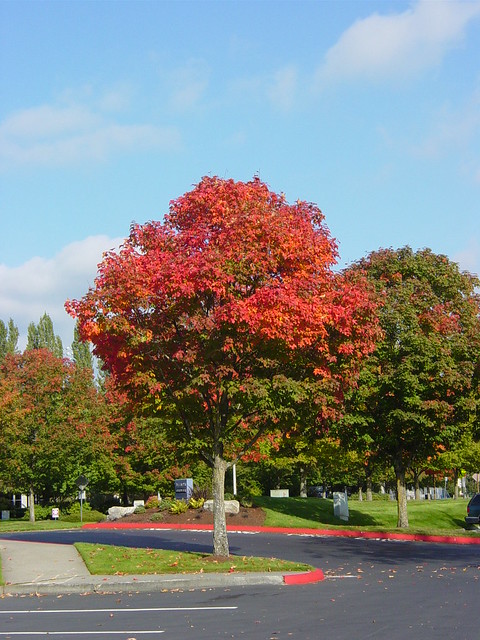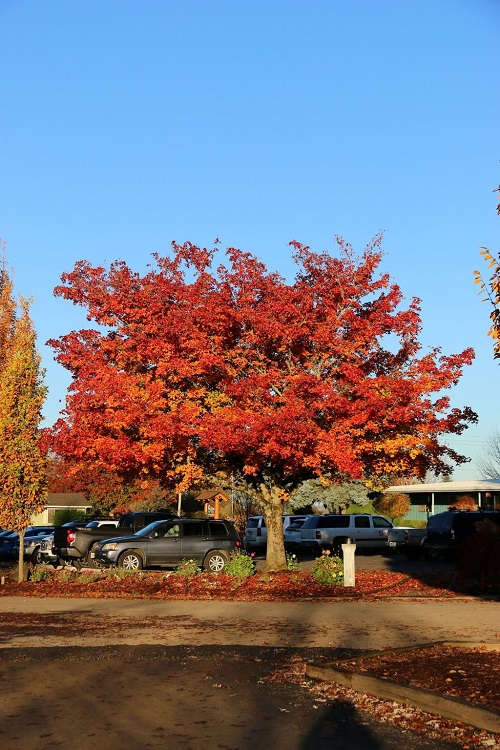Pacific Sunset Maple Tree offers a delightful display of colourful foliage that can add a vivid appeal to any landscape!

Follow this Pacific Sunset Maple Tree Growing Information guide that provides you insights from planting to care tips. Learn how to cultivate this vibrant and stunning specimen to your outdoor space.
Botanical Name: Acer x truncatum ‘Warrenred’
Common Names: Warrenred Pacific Sunset Maple, Pacific Sunset Maple Tree
Check out Tamukeyama Japanese Maple Growing Information here
Pacific Sunset Maple Tree Information
- Family: The Pacific Sunset Maple Tree, scientifically known as Acer truncatum ‘Warrenred,’ is a deciduous maple tree belonging to the Aceraceae family.
- Native Place: This tree is not native but is a hybrid resulting from the cross between the Shantung Maple (Acer truncatum) and the Norway Maple (Acer platanoides).
- Appearance: The Pacific Sunset Maple Tree is a moderately fast-growing tree that attains a height of around 30 feet and a width of approximately 25 feet. Its shape ranges from rounded to pyramidal, featuring a delicate branching structure and an upright growth pattern.
- Adaptability: This maple tree is favored for its adaptability to diverse climatic conditions, enduring both hot and cold environments.
- Hybrid Origins: The Pacific Sunset Maple Tree is a hybrid born from the union of the Shantung Maple and the Norway Maple. This blend incorporates the finest qualities of both parents. It inherits the glossy dark green leaves, enhanced fall color, and resilience to drought from the Shantung Maple, while its ability to thrive in various settings, quicker growth rate, and larger leaves are attributed to the Norway Maple.
- Flowers and Foliage: During the spring season, the Pacific Sunset Maple Tree adorns itself with small yellowish-green flowers prior to leaf growth. These blooms are modest yet pleasing. They eventually give way to distinctive samaras, measuring between 1.5 to 2 inches. The leaves of this tree are moderately sized, boasting an attractive shiny deep green color with serrated edges.
Fall Transformation
Staying true to its name, the Pacific Sunset Maple Tree undergoes a remarkable metamorphosis during autumn. The once-green leaves transform into a captivating display of autumnal hues, including shades of yellow, orange, and red.
Landscape Appeal
Appreciated for its manageable size, alluring foliage, and vibrant fall colors, the Pacific Sunset Maple Tree is often chosen as an ornamental addition to landscapes. Its graceful appearance and ability to thrive in various environments make it a sought-after choice for both visual beauty and adaptability.
Learn How to Grow a Japanese Maple Tree in a Pot
Propagating Pacific Sunset Maple Tree
Methods to propagate Pacific Sunset Maple Tree:
- Seed Propagation
- Softwood Cutting
- Grafting
Easiest Method: Seed Propagation
Seed Propagation is often considered the easiest method for propagating Pacific Sunset Maple Tree. Here’s how you can do it:
- Seed Collection: Collect seeds from mature Pacific Sunset Maple Tree in the fall. Look for seeds in the tree’s samaras, which are winged seeds found in pairs.
- Seed Preparation: Remove the seeds from the samaras and gently clean off any debris. Make sure to wear gloves, as the seeds can cause skin irritation.
- Stratification: Pacific Sunset Maple Tree seeds require a period of cold stratification to break dormancy. Place the cleaned seeds in a plastic bag with a damp paper towel and refrigerate them for about 90 to 120 days. This simulates the natural winter conditions.
- Planting: After the stratification period, sow the seeds in containers filled with a well-draining potting mix. Plant the seeds about 1/4 to 1/2 inch deep.
- Growing Conditions: Place the containers in a warm and bright location, but not under direct sunlight. Maintain consistent moisture in the soil.
- Transplanting: As the seedlings grow and develop several sets of true leaves, they can be transplanted into larger pots or directly into the garden, depending on the weather and their size. Gradually acclimate them to outdoor conditions if transplanting outside.
- Care and Maintenance: Provide proper care to the seedlings by watering regularly, protecting them from extreme weather, and monitoring for pests or diseases.
Check out Best Japanese Plants for Your Garden
Best Pot Size for Growing Pacific Sunset Maple Tree
- Initial Potting: For young Pacific Sunset Maple Tree, a pot with a minimum diameter of 18-24 inches is a good start. Ensure the pot has adequate drainage holes.
- Repotting: As the tree matures, it will require repotting into a larger container. Mature trees can thrive in pots as large as 26-34 inches in diameter.
Here are the Best Japanese Holly Bonsai Tree Pictures
Requirements for Growing Pacific Sunset Maple Tree
Sunlight
Pacific Sunset Maple Tree perform best when exposed to full sun, meaning at least 6 hours of direct sunlight per day. However, they can tolerate partial shade, which is about 3 to 6 hours of sun per day.
Morning sun is usually preferable as it is less harsh than afternoon sun. In hotter climates, some afternoon shade can be beneficial.
Adequate sunlight is critical for the tree’s vivid autumn color display. Lack of sufficient sunlight can lead to duller colors.
Soil
The Pacific Sunset Maple Tree thrives in loamy soil that has a good balance of sand, silt, and clay. Loamy soil provides excellent drainage, aeration, and retains moisture well.
Pacific Sunset Maple is relatively adaptable when it comes to soil acidity, but a slightly acidic to neutral pH range of 6.0 to 7.0 is considered optimal.
Poorly draining soils can lead to root rot and other diseases. Incorporate organic matter or sand to improve drainage if needed.
Water
- Young Trees: During the first year of growth, regular and consistent watering is crucial. Aim for 1 to 1.5 inches of water per week, either through rainfall or manual watering.
- Mature Trees: Established Pacific Sunset Maple Tree requires less frequent watering, generally every 2-3 weeks.
It’s better to water deeply and less frequently to encourage root development. Deep watering involves saturating the soil to a depth of at least 12-18 inches.
Avoid waterlogging the soil as this can lead to root rot. Well-draining soil is crucial.
Temperature and Humidity
The Pacific Sunset Maple Tree is hardy in USDA zones 4 to 8. This means it can withstand temperatures ranging from -40 F during winter.
While it prefers moderate humidity, it can adapt to various humidity levels. To ensure healthy growth, especially when young, provide consistent moisture during establishment and protect it from extreme temperature changes and strong winds.
Read the Pink Snowball Tree Care and Growing Guide
Pacific Sunset Maple Tree Care

Fertilizer
Type of Fertilizer
- Balanced Formula: A slow-release, granular fertilizer with a balanced N-P-K ratio like 10-10-10 or 14-14-14 is usually effective.
- Micronutrients: Opt for a fertilizer that includes essential micronutrients like iron and magnesium to ensure vibrant foliage.
Timing
- Spring Application: Early spring, just before new growth appears, is an ideal time to apply fertilizer.
- Fall Application: A lighter fertilization in early fall can prepare the tree for winter, but avoid late fall fertilizing as it can trigger new growth susceptible to winter damage.
Pruning
Best Time to Prune
- Late Winter: Pruning in late winter when Pacific Sunset Maple Tree is dormant minimizes sap loss and reduces the risk of disease transmission.
- Avoid Late Summer: Pruning too late in the summer can stimulate new growth that may not have enough time to harden before winter.
Pruning Techniques
- Dead or Diseased Branches: These should be removed immediately, regardless of the season.
- Thinning: Remove select branches to allow light and air to penetrate the tree’s canopy. This promotes healthy growth and reduces disease risk.
- Structural Integrity: For the young Pacific Sunset Maple Tree, focus on creating a strong branch structure by removing competing leaders and inward-growing branches.
- Height and Shape: For mature trees, occasional trimming may be required to maintain the desired shape and height, although Pacific Sunset Maples typically have a balanced natural shape.
Mulching
Apply a 2 to 4-inch layer of organic mulch around the base, avoiding direct contact with the trunk. Mulch conserves soil moisture, regulates temperature, and prevents weed growth. Refresh the mulch annually, and ensure it doesn’t accumulate against the tree.
Pests
- Aphids: Tiny insects that suck sap from leaves, causing distortion and honeydew secretion.
- Scale Insects: These pests attach to the branches and leaves, damaging the tree by feeding on plant fluids.
- Caterpillars: Some caterpillar species can defoliate the tree if their populations are high.
Diseases
- Tar Spot: Fungal disease that causes black spots on leaves, affecting the tree’s aesthetics.
- Anthracnose: Another fungal disease leading to leaf spots, defoliation, and twig dieback, particularly in wet conditions.
- Verticillium Wilt: Fungus causing wilting and yellowing of leaves due to restricted water flow within the tree.
To prevent and manage these issues, ensure good air circulation, maintain proper hygiene by removing fallen leaves, and choose disease-resistant varieties when possible. Regular inspections and early intervention are key to keeping your Pacific Sunset Maple Tree healthy.
Discover Beautiful Trees with Yellow Flowers
Pacific Sunset Maple Tree – Frequently Asked Questions
Q: What USDA hardiness zones are suitable for Pacific Sunset Maple?
A: Pacific Sunset Maple thrives in USDA Hardiness Zones 4-9.
Q: How tall does a Pacific Sunset Maple get?
A: This tree typically reaches a height of 25-30 feet and a similar spread.
Q: What type of soil is best for Pacific Sunset Maple?
A: Loamy soil with good drainage and a slightly acidic to neutral pH (6.0-7.0) is ideal.
Q: How often should I water a Pacific Sunset Maple?
A: Young trees need about 1 to 1.5 inches of water per week. Mature trees generally require watering every 2-3 weeks, depending on climate and soil conditions.
Q: When should I fertilize my Pacific Sunset Maple?
A: Early spring and early fall are the best times for fertilization.
Q: Do I need to take any special care of the tree during winter?
A: Mulching around the base of the tree can help insulate the roots in colder climates.
Q: Is Pacific Sunset Maple disease-resistant?
A: Yes, it’s known for good resistance against common tree diseases like powdery mildew and leaf spot.
Q: Can the tree be grown in a container?
A: While it’s possible to start this tree in a large container, it will eventually need to be transplanted into the ground due to its mature size.



